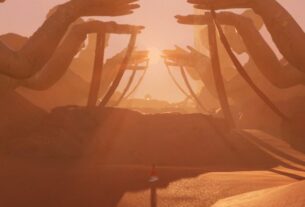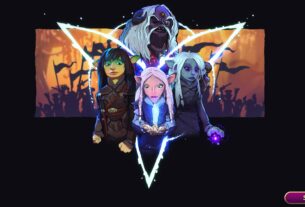
Dauntless brims with energy. It’s in everything from the exuberant use of color to the larger-than-life Behemoths with cheeky nods to the developer’s Canadian roots. Monster Hunter: World’s high-realism design almost feels grimdark in comparison to the Shattered Isles’ Crayola color scheme of glamors and on-the-nose armor designs. The game has chutzpah, but it lacks that little bit more to keep you properly engaged in its monster hunting fracas.
At first glance, Dauntless looks and appears to play like a beginner-friendly version of Capcom’s monster-slaying franchise. After a robust character creator (which features some nice non-gender conforming options), you’re thrust into a dangerous world via an unceremonious plane crash. The premise behind your existence here is a simple one which isn’t really brought up ever again: you need to kill things that are making the place dangerous, and killing these enormous things sometimes involves calling upon your mates for help. Hunt, slay, repeat. Hunting the giant monsters that stalk the Shattered Isles, slaying them, and repeating it until you’ve gathered enough parts to make a cape out of tailfeathers is something that you repeat ad infinitum.
The game’s Behemoths are intelligent, deadly, and initially occupy a strange space between fantastical and woodland creatures. You find yourself taking up arms against killer beavers, oversized owls, and angry turtles. The beaver feels like a tongue-in-cheek nod to the developer’s Canadian origins, and because the early reference points are mostly animals that we’re familiar with (as opposed to more esoteric dinosaur-dragon hybrids), it means that there’s a level of innate predictability in how some of these creatures fight. The Gnasher, our beaver-like friend, will slap you around with its oversized tail. The Shrike, a gigantic killer owl, flies around and uses its wings to create tornadoes. The Embermane, an analog for a lion, prances and pounces like the best of them in the Serengeti. The fact that these initial monsters have physiques and species archetypes that occur naturally in our world makes them less, well, daunting. Behemoth designs become more intricate once you’ve left the relative safety of the first few locations and have to contend with insects shooting deadly lasers at you, but by and large, you’re fighting creatures that you can intuit a solution for.
This means that the beasts can lack the same gut-punch effect upon first sight that you may be used to from facing down prehistoric nightmares in other games, exacerbated by the cartoony art direction and the game’s straightforward approach to hunting. Dauntless gives you access to an assortment of weapons which all vastly affect the hunting experience. From dual-wielding guns to teleporting with chain blades, there’s a good variety that caters to different styles. Bladed weapons are better for slicing off monster parts, while others crush skulls more effectively. No matter what you pick, you’re going to be able to bring something valuable to a group situation.
That being said, once you figure out the basics of knocking bits off Behemoths using a mixture of heavy attacks, light attacks, and special skills, that’s really all you’ve got to worry about in the heat of the moment. The only concern in any hunt is the slavering monster trying to eat you up–no need to worry about finding respite, concocting traps, or anything related to the idea of tracking your prey. Dauntless isn’t drinking from the well of realism by any means, but the lack of these touches ultimately make it hard to stay engaged in the moment. This isn’t to say that the fights themselves lack the difficulty required to get your heart rate up; a total wipe becomes more common as you start throwing yourself against bigger and badder critters. That being said, the lack of verticality and overall variety in terrain means that there’s simply not a lot to parse.
This same feeling of just falling a little short is also present when it comes to the fifteen or so hours of the core story. Monster Hunter: World worked off an involved, overarching single-player narrative to guide you from each unique in-game location to another in your quest to push a dying, continent-sized lizard out to sea. Conversely, Dauntless gives you an almost-administrative motivation for your actions. You need to clean things in the overworld because, well, it keeps people safe. Also, hope you’ve got time to gather fifteen stalks of a plant in-between trying to knock the skull off a giant monster, because a quest-giver back home is scientifically curious.
There’s not much of an attempt to get you particularly invested in the main campaign, which means that if you’re someone who prefers taking down ice-spewing owlbears solo, your only true motivation is going to be the satisfaction of throwing yourself at said ice-spewing owlbear. If you’re playing alone, you can end up feeling isolated. This is the most noticeable in the game’s hub world, Ramsgate. Even when the servers are bustling (we’re talking matchmaking queues that are 100,000 players deep), there’s a distinct lack of reflection of that in Ramsgate. The place feels empty, with perhaps only a handful of people standing around.
The NPCs feel like a lost opportunity in the same vein. While you will be undoubtedly happy that you can pet the dog (and hopefully, the rams), and that the local blacksmith is serving high-fashion lumberjack looks for days, the aesthetic appeal is where it ends. There’s no feeling of life to Ramsgate. No roaming vendors, no murmuring chit-chat when things get busy. There are swaths of bare corridors and paths for you to sprint down, but by and large, the town exists for you to pick up collectibles and quests. Everyone that you can talk to looks like they’re hiding a cool backstory, but you never get to experience it.











The multiplayer side of things is where Dauntless really shines, and the reality is that the title feels optimized for it. Cross-platform compatibility has been available since launch day, which means that regardless of whether you’re slaying Behemoths on PC, PlayStation 4, or Xbox One, your multiplayer pool will encompass all three. This is advantageous because matchmaking is, in practice, refreshingly seamless. No need to fiddle with a menu or five, and it’s nice that each platform’s native friends lists are imported into the client. Matchmaking usually takes a matter of seconds, which makes Dauntless feel very plug-and-play in the best way.
The game is not without its quirks, however–opening up a menu as you’re finishing a hunt might trap you in there, unable to exit out. Going into a hunt with a group of friends and becoming stuck on the loading screen until you relog will kick you from the party and the endeavor. You could also fall into part of the landscape at Ramsgate and be unable to extricate yourself without restarting the client. Something as simple as ensuring that the hotkey to interact with things works each and every time is not a foolproof feature yet, which can lead to repeat frustrations at inopportune times.
Dauntless is also a free to play game. It’s impressive in terms of what it offers in terms of content, accessibility, and the fact that you aren’t constantly bludgeoned over the head with the need to spend any real money on anything. There are dyes, cute emotes and other cosmetic improvements which are part and parcel of F2P, and also a “Hunt Pass” which rewards players for completing in-game objectives. There isn’t the ability to purchase your way to a sure victory against the Behemoths and the relatively unobtrusive presence of the F2P elements like the various in-game shops means that you can spend absolutely nothing and not feel like you’re missing out at all unless you’re a fiend for glamoring your gear.
Overall, Dauntless is clearly an experience that has been optimized to deliver the most stress-free multiplayer session possible. From the seamless crossplay to the way that anyone can hop into a game and confidently take up arms against formidable foes, it’s refreshingly accessible and looks great to boot. While it can feel a little empty, and there are bugs that mar the experience here and there, its fresh look and lively spark are more than enticing enough to warrant a spin.



